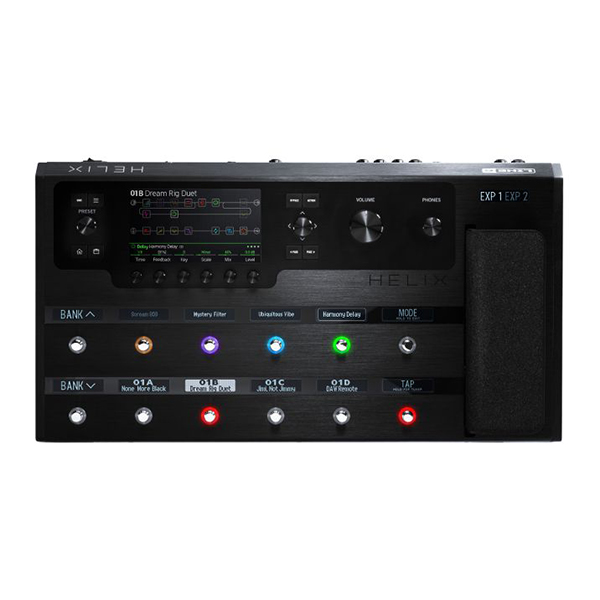Jeff Schroeder on the Virtues of Running Delay and Reverb Before Distortion
by Jeff Schroeder
I hope everyone is doing well as 2021 is coming to an end. Over the past year, it’s been an extreme pleasure writing these entries for Model Citizens, and it’s something I plan on continuing into the future. The community of players, software designers, and editorial staff surrounding Helix and other Line 6 products is very special. I consider it a privilege and an honor to be part of this wonderful group of people.
For this entry, I’d like to discuss running delays and reverbs into fairly distorted sounds (via pedals or amp models). As we all know, pedal order is—and should be—a subjective process of discovery and exploration. That being said, there are some choices that are more common than others. I find that most players prefer to place effects like modulation, pitch shifting, delay, and reverb after distorted tones, and that is also what I do most often—but there are no rules and experimenting with effect chain order can produce some wonderful results.
Recently, I got together with my former “noise-pop” band the Lassie Foundation and played a few of the old songs to promote our crowd-funding campaign to reissue a few of our albums on vinyl, and that provided me with an opportunity to revisit how I ordered my effects in the past.
We were heavy disciples of guitarist Brad Laner and his band Medicine. If you aren’t familiar with them I strongly urge you to check them out, and that will provide a key to understanding where I am going conceptually in this post. Laner had a very unconventional guitar rig that he used to create a sort of “fuzz-from-another-dimension” sound, and at the heart of it was a four-track recorder (with all the input levels maxed out) that served as his distortion pedal. But he also ran all his delays and reverb in front of the four-track, which created a beautiful mess of a sound that was absolutely transcendent. The Lassie Foundation adopted this idea and we ran all our effects into our distortion pedals.
When Eric Campuzano (the other guitar player in the Lassie Foundation) and I set out to recreate our previous guitar sounds, we decided to use Helix in place of pedals, and we both concluded that Helix actually sounded much better than either of our old rigs. The world has changed a lot in 20 years.
Before delving into the more shoegaze-style applications of this concept, however, I’d like to take a quick look at the history of the technique. Until the advent of effects loops and devices such as Bradshaw switching systems, there really weren’t any alternatives to plugging devices such as Echoplex tape delays directly into the front of an amplifier. Meaning, if you wanted to overdrive your amp, you had no choice other than to also distort your delays.
Of course, players such as David Gilmour used clean amps and more conventional pedal orders to get beautiful tones, but there is something really cool that happens when running a tape-style delay into a distorted amp, and many modern players like to do this. For example, Billy Corgan runs all his effects directly into the front of his amps, whether they are clean or distorted.

In Audio Example 1, I’m basically playing the chords to Van Halen’s “Ain’t Talkin’ ‘Bout Love” as an example of what this type of setup can sound like. If you listen closely to the Van Halen recording you can pretty easily hear the echo repeat when Eddie plays the riff. It definitely adds a texture to the sound and once you hear it, it’s hard to imagine the riff without it. If you look at the pedal order in the Old School preset, it essentially replicates a traditional pedalboard setup with all the effects running into a fairly distorted modified plexi type of amp provided by the Placater Dirty. However, in this case, I did put a plate reverb at the very end of the chain to provide a bit of ambience to help sweeten the sound. In this particular type of application, I enjoy how both the phaser and the flanger sound running into the front end of the amp. Live with the Smashing Pumpkins, this how I would most often use both phasing and flanging with distorted sounds.
In Audio Example 2, after a quick KISS-like riff just for fun, I play a couple of guitar licks to demonstrate how Echoplex-type delays sound when used in this situation. Notice that while playing the delays get quieter and then get louder once the note has stopped sounding. Once you’ve downloaded the Old School preset, try playing around with different phasers, flangers, and chorus models to see how different they sound and react when placed in front of the amp.

Audio Example 3 is a Lassie Foundation song called “Crown of the Sea” from our forthcoming Cave Sessions release. As I mentioned previously, putting together the presets for these recordings inspired me to revisit the idea of running delays and reverbs (and other effects) into distorted sounds. This song, in particular, makes great use of this concept. For the Crown of the Sea preset, I decided to build my signal chain around a completely cranked Hiwatt-style amplifier, which I certainly didn’t have when the song was recorded originally. The WhoWatt 100 model in Helix has a much different distortion characteristic than my usual choice of something in the Marshall territory. What I like about the WhoWatt is how clear the repeats are from the first delay in the signal chain. That’s always something I’m striving when creating these types of tones: energy from the distortion but with as much clarity as possible from the effects.
Another thing to note about this preset is that I run a distortion pedal before my wah pedal. Doing this makes the sweep and the tone of the wah much more extreme and a bit out-of-control sounding. Unlike the previous preset, in this one I placed a stereo chorus post-amplifier to create a wider, more lush sound that harkens back a little to that coveted Cocteau Twins territory. My Crown of the Sea preset is also included in the download.

Audio Example 4 is an excerpt from a demo I made using a preset I recently created. What I like about the Destruction preset is the amount of energy the delay repeats provide as a result of hitting such a large amount of distortion. You have to constantly be reacting to what is coming back at you. In both this and the previous preset, you’ll notice that I like to run a mono delay and reverb before my distortion, and then I like to add some stereo effects post-amplifier to impart depth and dimension to the sound. I placed an octave-up pitch shifter on a momentary switch in the bottom left corner of the Helix. In adding this effect to the chain, the placement of it was quite significant. For a while, I had it after the second distortion and was really enjoying what was taking place. Because of all the distortion and delays hitting the input of the pitch shifter, it wasn’t tracking accurately, which was actually quite fun. In the end, I decided to place before the second distortion pedal in the signal chain because the tone of the pitch shifting was a bit clearer. That being said, if you’re feeling a little adventurous, try placing it right after the second distortion pedal. This last preset has a lot going on in it and the four snapshots show you a few different ways to explore some of the different combinations of sounds.
Of course, these presets were created for my own personal applications using my guitars, and they should only serve as starting points for your own explorations. Please play around with EQ and gain settings to suit the output of your own guitars. Until next time …

Jeff Schroeder is a musician based in Los Angeles. He currently plays guitar in the Smashing Pumpkins and Night Dreamer. Besides guitar, Jeff is obsessed with coffee and 20th century experimental literature.
Learn more about Helix.
Main Image: Travis Shinn
Related posts
Leave a Reply
You must be logged in to post a comment.
By submitting your details you are giving Yamaha Guitar Group informed consent to send you a video series on the Line 6 HX Stomp. We will only send you relevant information. We will never sell your information to any third parties. You can, of course, unsubscribe at any time. View our full privacy policy






Just bought an LT, and saw a mention of this blog on a facebook group. Excellent post, thank you for sharing such deep craft! I’m looking forward to checking out this entire series now, I know I’m going to learn a ton.
Thanks Jeff! All your Line 6 ipresets, also the ones from the past, are incredible and beautiful, I use them with great satisfaction. Thanks again.
I use a POD GO and going back thru some Pumpkins classics I realized all the cool reverse delay you seem to use….great effect. Mainly thanks for the post and sharing your knowledge !!
Absolutely great-sounding and usable tones and soundscapes from Jeff, as always. I especially audio example #4 and tips like where in the signal to put the pitch shifter and before which distortion pedals are both time-saving and provide valuable insight. Thank you!
The examples all sound good to me. This is one of those things that sound good when other people do it but I can’t stand doing it myself. Wahs are another LOL